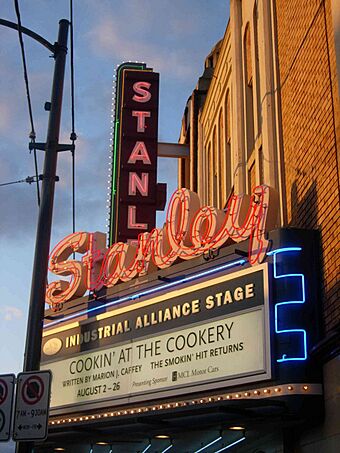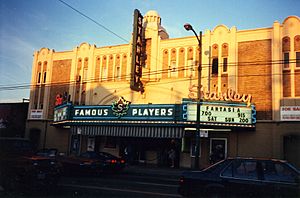Stanley Industrial Alliance Stage facts for kids

The theatre in 2007
|
|
| Former names | Stanley Theatre Stanley Theatre du Maurier Stage |
|---|---|
| Location | 2750 Granville Street Vancouver, British Columbia V6H 3J3 |
| Owner | Arts Club Theatre Company (formerly owned by Famous Players) |
| Type | Live theatre (former movie palace) |
| Capacity | 650 (formerly 1,216) |
| Construction | |
| Opened | December 15, 1930 |
| Closed | September 21, 1991 |
| Reopened | October 28, 1998 |
The Stanley Industrial Alliance Stage, which used to be called the Stanley Theatre, is a famous theatre in Vancouver, British Columbia. It is located at 12th Avenue and Granville Street and is the main stage for the Arts Club Theatre Company.
The Stanley first opened in December 1930 as a grand movie palace. For over 60 years, it showed popular films. But in 1991, it had to close down. Many people worried it would be turned into stores. Instead, it was saved and renovated between 1997 and 1998 to become a stage for live plays. Because of its history, it was named a special heritage building.
Today, the Arts Club uses the Stanley to perform classic plays and big Broadway musicals. Famous shows like My Fair Lady, Miss Saigon, and Disney's Beauty and the Beast have been on its stage. The theatre's name was changed to the Stanley Industrial Alliance Stage in 2005 after a company called Industrial Alliance helped support it.
Contents
History of the Theatre
A Grand Movie Palace
The Stanley Theatre opened on December 15, 1930. It was built by Frederick Guest, who wanted to create his dream theatre in Vancouver. He hired architect Henry Holdsby Simmonds to design it. The outside of the theatre was built in a modern Art Deco style, while the inside was a beautiful neoclassical style with seats for 1,216 people.
To make the theatre special, Simmonds used the best materials he could find. This included special stone from Winnipeg and tiles from Italy. The theatre also had fancy chandeliers and carpets. It was named after Lord Stanley, a former Governor General of Canada, just like Stanley Park and the Stanley Cup.
The very first movie shown was One Romantic Night. Back then, a ticket cost only 10 to 40 cents. In 1941, the theatre was bought by the company Famous Players.
Showing Blockbuster Movies
The Stanley became a very popular place to see movies. It often showed blockbuster films that drew crowds from all over Vancouver. Some of the famous movies shown there included The Exorcist, The Muppet Movie, The Empire Strikes Back, Poltergeist, Indiana Jones and the Temple of Doom, and Top Gun.
The theatre kept updating its technology. It got better sound systems like Dolby Stereo and high-quality THX sound. This made watching movies there a great experience.
However, by the 1990s, fewer people were going to the movies, and Famous Players had to close the Stanley. The last movie shown was Fantasia on September 25, 1991. At the time, it was the oldest movie theatre still running in Vancouver.
Becoming a Live Theatre
Saving the Stanley
After it closed, the Stanley was put up for sale. The plan was to turn the inside into shops while keeping the historic front of the building. But a group of people started a "Save Our Stanley" campaign to protect the theatre.
In 1997, the Arts Club Theatre Company was able to buy the Stanley for over $3 million. They raised money from the government, the City of Vancouver, and many supporters to pay for the building and the major renovations it needed.
A Major Renovation
The renovation turned the old movie palace into a modern theatre for live plays. The stage was made twice as big, and a 25-metre-tall "fly tower" was added to lift scenery up and down. New dressing rooms and a backstage area were also built.
The number of seats was reduced from over 1,200 to 650. This makes the theatre feel more intimate, so the audience is closer to the actors. The beautiful gold-leaf decorations on the ceiling were carefully restored. For all this hard work, the theatre won awards for its design and preservation.
The reopening of the Stanley also helped the neighborhood. New shops and restaurants opened nearby, making the area a more exciting place to visit.
The Stanley Today
The Stanley reopened as a live theatre on October 28, 1998. The first show was the musical Swing!, which was a big hit. Since then, the Arts Club has used the stage for many of its biggest productions.
The theatre allows the Arts Club to perform large-scale musicals and classic plays that need a big stage. It has become one of Vancouver's most important and beloved cultural landmarks.
Recent Productions
Here are some of the shows that have been on stage at the Stanley in recent years.
| 2019–2020 season | |
|---|---|
| Show | Run Dates |
| A Thousand Splendid Suns | September 12, 2019 – October 13, 2019 |
| The Sound of Music | November 7, 2019 – January 5, 2020 |
| Noises Off | January 23, 2020 – February 23, 2020 |
| carried away on the crest of a wave | Cancelled due to COVID-19 |
| Kinky Boots | Cancelled due to COVID-19 |
| 2018–2019 season | |
|---|---|
| Show | Run Dates |
| The Curious Incident of the Dog in the Night-time | September 6, 2018 – October 7, 2018 |
| Sweat | October 18, 2018 – November 18, 2018 |
| Disney's Beauty and the Beast | December 1, 2018 – January 6, 2019 |
| The Matchmaker | January 24, 2019 – February 24, 2019 |
| The Orchard (After Chekov) | March 21, 2019 – April 21, 2019 |
| Matilda the Musical | May 16, 2019 – July 14, 2019 |
Images for kids
See also
- List of heritage buildings in Vancouver
- Theatre in Canada
- South Granville Rise
- Orpheum (Vancouver)




